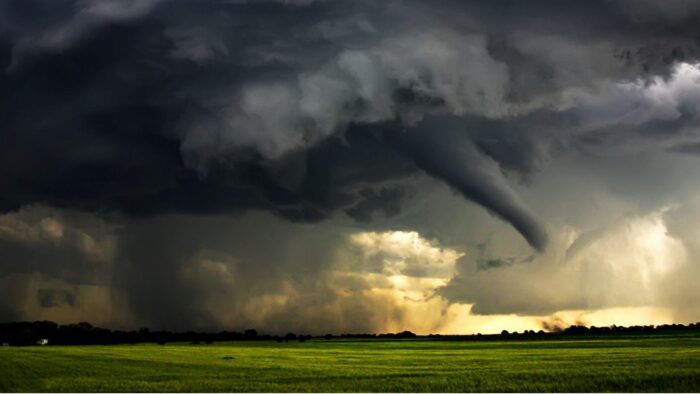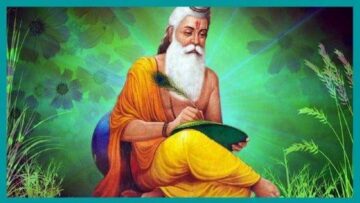Climatology is a study of the Weather. It helps people to predict and understand the weather changes from time to time. Vedas being the fountainhead of knowledge, various references are available in Vedas regarding the seasons based on the climates. Ṛg Veda divides the whole year into six seasons (ṚV.I.23.15; II.40.3.) and further into three big divisions – hot, wet and cold (ṚV. I.164.46).
ṚV. I, 95.3; I.164. 15 considers Sun as the determinant of seasons. It also denotes VII.70.2 and I.161. 11-12 that the rays of the Sun is the reason for rainfall and describes about radiation, convection-current and rainfall too.
Insolation, evaporation, moisture, clouds, rainfall and their relationship with clouds are also described in ṚV. (I. 141.2; I.19.7-8). It also mentions about the sixty-three and forty-nine types of winds in two mantras. (ṚV. VIII.85.8 and v.52.17)
The Sāmaveda I.13, p. 84 gives details about the height of the clouds and its movements in mountanious altitude.
The Pṛthvi-sūkta of Atharva Veda (XII.1.51) speaks of violent dusty storm and names it as ‘mātariśvā’. The Taittirīya Āraṇyaka (I.9.4-5) talks about seven types of air current or winds that produce seven types of clouds.
The Epics talks of the seven region in the atmosphere (M.Bh. XII.329. 36-541) in detail. The Vanaparva (III.3.49) deals with causes of rainfall (skandhas).
Following their lead, the Puranic Literature also provides great detail regarding climatology.
The Matsya, Vāyu and Viṣṇu Purāṇas deal with the role of the sun in the rainfall phenomenon. According to them the Sun’s rays absorb the waters of the oceans, rivers and so on at the appropriate time of the year, characterised by the season or Sun’s position. The water vapours get transferred to the clouds which under the influence of favourable winds pour rain on earth for six months accompanied by thunder and lightning (Matsya Purāṇa 124.(29-34):
वैवस्वतेसंयमने मध्याह्ने तु रविर्यदा।
सुषायामथवारुण्यामुत्तिष्ठन् स तु दृश्यते॥
विभावर्यामर्द्धरात्रं माहेन्द्र्यामस्तमेव च।
सुषायामथ वारुण्यं मध्याह्ने रविर्यदा॥
विभावर्य्यां सोमपुर्य्यां उत्तिष्ठति विभावसुः।
महेन्द्रस्यामरावत्यामुद्गच्छति दिवाकरः॥
अर्द्धरात्रं पर्येति भानुरालातचक्रवत्।
स शीघ्रमेव पर्येति भानुरालातचक्रवत् ॥
भ्रमन् वै भम्माणानि ऋक्षाणि चरते रविः।
एवं चतुर्षु पार्श्वेषु दक्षिणां तेषु सर्पति॥
उदयास्तमये वऽसावुतिष्ठति पुनः पुनः।
पूर्वाह्णे चापराह्णे च द्वौ द्वौ देवालयौ तु सः॥
The Vāyu Purāṇa makes special mention of the rainfall cycle by which the same water goes up and comes down as rain (51.13-16a):
परिवर्त्त क्रमाद्विप्रा भाभिरालोकयन् दिशः।
सूर्यः किरणजालेन वायुयुक्तेन सर्वशः।
जगतो जलमादत्ते कृत्स्नस्य द्विजसत्तमाः॥
आदित्यपीतं सूर्याग्नेः सोमं संक्रमते जलम्।
नाडीभिर्वायुयुक्ताभिर्लोकाधानं प्रवर्तते॥
यत्सोमात् स्रवते सूर्यस्तदग्रेष्ववतिष्ठते।
मेघा वायुनिघातेन विसृजन्ति जलभुवि॥
एवमुत्क्षिप्यते चैव पतते च पुनर्ज्जलम्।
The Viṣṇu Purāṇa 2.9 (8 – 12) describes garbha as lasting for the eight months. Since the rainfall period in north India lasts for about four months. (Wether Science in ancient India, A.S. Ramanathan) :
येन विप्र विधानेन तन्ममैकमनाः श्रुणु।
विवस्वानष्टभिर्मासैरादायापो रसात्मिकः॥
Various Purāṇas speaks about the winds and its circulation. The Brahmāṇḍa, Vāyu, Liṅga and Matsya Purāṇas provide the detailed description about the phenomena of evaporation, cloud formation, classification of clouds and their relationship with winds or regions of atmosphere (B.P. Ch. 22; V.P. ch. 51; M.P. ch.125).
Brahmāṇḍa, Vāyu and Matsya Purāṇas mention on Vātaskandha – seven layers in atmosphere or seven types of winds in the atmosphere (BP. 19.171)[1]:
रसातलतलाः सप्त सप्तैवोर्द्धतलश्च ये।
सप्तस्कंधस्तथा वायोः सब्रह्मसदना द्विजाः॥ [2]
The Matsya Purāṇa (163.32-33) lists them by name as āvaha, pravaha, vivaha, udāvaha, parāvaha, samvaha and parivaha
आवहः प्रवहश्चैव विवहोऽथ ह्युदावहः ।
परावहः संवहश्च महाबलप्राक्रमाः॥
तथा परिवहः श्रीमानुत्पात – भयशंसनाः।
इत्येवं क्षुभिताः सप्त मरुतो गगनेचराः॥
Brahmāṇḍa Purāṇa (19.172a) further says that there winds have five types of movement or circulation:
आपतालाद्दिवं यावदत्र पंचविधा गतिः।
Nārada Purāṇa speaks about the Saptaite vāyumārgaḥ– seven air channels or winds. The first one is pravāha which drives along the first course, masses of clouds born of smoke and heat. Passing through the sky, and coming into contact with the water in clouds, this wind shows itself in efulgence among darts of lightning (N P. 60.13, 17- 18):
प्रेणनाच्चैव सर्वेषां प्राण इत्यभिधीयते।
प्रेषयत्यभ्रसंघातान्धूमजांचोष्मजांस्तथा॥
प्रथमः प्रथमे मार्गे प्रवहो नाम सोऽनिलः।
अंचरेस्नेहमात्रेभ्यस्तदिद्भ्यश्चोत्तमद्युतिः॥
The second wind called āvaha, blows with a loud noise. It makes Some (the moon) and the other luminaries rise and appear (N P. 60.19):
आवहो नामे सोऽभ्येति द्वितीयः स्वसनो नदन्।
उदयं ज्योतिषां शश्वत्सोमादीनां करोति यः॥
Third one which drinks up the water from four oceans and gives it to the clouds in the sky and presents them to the gods of rain is called by name udvaha (N.P. 60. 20-22A):
अंतर्देहेषु चोदानं यं वदंति मनीषिणः।
यश्चतुर्भ्यः समुद्रेभ्यो वायुर्द्धारयेत् जलम्॥
उद्धृत्य ददते चापोजिमूतेभ्यो वनेऽनिलः।
योऽद्भिः संयोज्य जीमूतान्पर्जन्याय प्रयच्छति॥
उद्वहो नाम बंहिष्ठस्तृतीयः स सदागतिः।
The wind which supports the clouds and divides them into various parts, melts them for pouring rain and once more solidifies them, which is perceived as the sound of roaring cloud is known by the name of samvaha (N.P. 60. 22b, 23a, 24a):
संनीयमाना बहुधा येन नीला महाघनाः॥
वषमोक्षकृतारंभास्ते भवंति घनाघनाः।. . .
चतुर्थः संवहो नाम वायुः . . . ॥
The fifth wind has great force and speed. It is dry and roots out and breaks down all trees. Existing with it, the clouds are called vivaha. They create sound in the sky. The sixth wind parivaha takes place illuminating through rays and causes refraction. The seventh paravaha is perhaps some cosmic region which cannot be resisted by anyody (N.P. 60.25, 28a, 32a):
पंचमः स महावेगो विवहो नाम मारुतः ।
यस्मिन्परिप्लवे दिव्या वहंत्यापो विहायसा॥
षष्ठः परिवहो नाम स वायुर्जीवतां वरः।
परीवहो नाम वरो वायुः स दुरतिक्रमः।
Discussing the general genisis of the clouds the Vāyu Purāṇa says that there is moisture content in all the movable or immovable objects of the world and due to sun’s rays evaporation of that humidity takes place and this process produces clouds (V.P. 51. 23-25a):
तेन चाभ्राणि जायन्ते स्थानमत्राम्भसां स्मृतम्।
आर्कन्तेजो हि भूतेभ्यो ह्यादत्ते रश्मिभिर्जलम्॥
समुद्राद्वायुसंयोगाद्वहन्त्यापो गभस्तयः।
यतस्त्वृतुवशात् काले परिवर्त्तो दिवाकरः ।
यच्छत्यपो हि मेघेभ्यः शुक्लाःशुक्लगभस्तिभिः॥
अभ्रस्था प्रपतन्त्यापो वायुना समुदीरिताः।
Oceans, winds or atmosphere and sun’s rays or insolation play the dominant role in giving rains. Winds determine the distribution of the rainfall.
The Vāyu (1.26-40) and Brahmāṇḍa Purāṇa (22.30-43) give the details of the clouds. the clouds which sprinkle water are called megha and – which do not bring any rainfall are called abhra. There are three types of clouds – आग्नेय, ब्रह्मज and पक्षज ( Brahmāṇḍa, 22.30):
मेघानांपुनरुत्पत्तिस्त्रिविधायोनिरुच्यते।
आग्नेयाब्रह्मजाश्चैवपक्षजाश्चपृथग्विधः॥
According to the Brahmāṇḍa and Vāyu Purāṇas, Āgneya occurs in the winter season. It brings rainfall within a radius of a mile or two. The Brahmaja clouds are produced due to These have lightning and send out deep rumbling. In percipitation they cover an area or radius of nearly a yojana (five or eight miles). Most pobably these are cumulonimbus. The Puṣkarā-vartaka or the pakṣaja clouds originate from or in the wings of mountains. They assume various forms and produce deep rumbling sound. They are full of profuse water and bring excessive rainfall which is extremely destructive. This description conforns to a large extents to the modern class of altostratus.
The Matsya Purāṇa gives the elaborate information regarding the clouds, its formation, nature and shape in a separate chapter[3].
Then the Skanda Purāṇa records “It is the pravaha wind or air current which makes the clouds produced by smoke and thermal activity, full of water, so that the clouds taking blue colour give copious rainfall” (Maheśvara Khaṇḍa, 38.58):
प्रवहेषुपञ्चमःसोऽपिविवहोनाममरुतः।
ग्रहचक्रमिदंयेनभ्राम्यतेध्रुवसन्धितम्॥
Process of condensation and percipitation on hydroscopic nuclei are very carefully described in nut-shell, thus,:”The waters from the (vapours) of the clouds when brought into contact with the wind fall in the shape of rain” (Matsya, 125.33):
नियच्छत्यापोमेघेभ्यःशुक्लाःशुक्लैस्तुरश्मिभिः।
अभ्रस्थाःप्रपतन्त्यापोवायुनासमुदीरिताष्ः॥
The Viṣṇu Purāṇa very scientifically enumerates the four sources of atmospheric moisture, “The glorious Sun, O Maitreya, exhales moisture from four sources, namely – seas, rivers, the earth and living creatures”(II.9.11):
सरित्समुद्रभौमास्तुतथापःप्राणिसम्भवाः।
चतुष्प्रकाराभगवानादत्तेसवितामुने॥
The Brahmāṇḍa Purāṇa further describes about mountanious rainfall and montanous flanks receiving copious rain (19.85-86):
वृष्ट्यर्थं जलदास्तत्र प्रभंवति च यांति च।
तस्यापरेण सुमुहाञ्जलधारो महागिरिः॥
यतो नित्यमुपादत्ते वासवः परमं जलम्।
ततो वर्षं प्रभ्वति वर्षाकाले प्रजास्विह॥
Modern meterology tells us that polar winds actually never bring any rainfall in the year in the regions under their influence – flanking poles or Tundra, and only scanty summer rain occurs in those areas due to the sweeping of strong westerlies. The same fact is stated in the Purāṇic line, ” ध्रुवेणाधिष्ठितो वायुर्वृष्टिं संहरते पुनः – the air from the pole drives away the rain”(125.36):
ध्रुवेणाधिष्ठितो वायुर्वृष्टिं संहरते पुनः।
ग्रहान्निवृत्या सूर्य्यात्तु चरते ऋक्षमण्डलम्॥
The Matsya Purāṇa furnishes still more elaborate and scientific information regarding clouds. It says that the clouds jīmuuta beget life. Those clouds remain suspended on the air Āvaha. They change shape and going up a yojana from there form into rain hence they are called the source of rain. The clouds puṣkaraavarta assume various forms, give out thundering noise, produce deluge of rains. The chief source of nourishment is smoke . The most important of those clouds is parjanya.
To the north and south of the snow-clad moutains occurs the puṇḍra cloud which greatly increases the stock of rain. All the rain formed there converts itself into the snow. The wind on the himavat draws by its own force those snow flakes and pours them on the great mountains. Beyond the himavat there occurs little rain. Thus here is a reference to a very important geographic fact of scanty rainfall or arid condition of the Tibetan plateau. The study and knowledge of this fact is really creditable on the part of those ancient Indians (125.20-25):
षष्ठः परिवहो नाम वायुस्तेषां परायणः।
योऽसौ बिभर्ति भगवन् गञ्गामाकाशगोचराम्॥
दिव्यामृतजलां पुण्याम् त्रिपथामिति विश्रुताम्।
तस्या विस्पन्दितं तोयं दिग्गजाः पृथुभिः करैः॥
शीकरान् सम्प्रमुञ्चन्ति नीहार इति स स्मृतः।
दक्षिणेन गिरिर्योऽसौ हेमकूट इति स्मृतः॥
उदग् हिमवतः शैलस्योत्तरे चैव दक्षिणे।
पुण्ड्रं नाम समाख्यातं सम्यग्वृष्टि विवृद्धये॥
तस्मिन् प्रवर्तते वर्षं तत्तुशारसमुद्भवम्।
ततो हिमवतो वायुर्हिमं तत्र समुद्भवम्॥
आनयत्यात्मवेगेन सिञ्चयानो महागिरिम्।
हिमवन्तमतिक्रम्य वृष्टिशेषं ततः परम्॥
Conclusion:
The Jyotiṣa texts like Bṛhat Samhita, Adbhuta Sāgara, Meghamālā, Buddhist and Jain works are developed from the concepts given in the Purāṇas.
After studying the Purāṇas, We can clearly infer that the information available in the modern science are already there in Purāṇas. This paper is an humble effort to render the important matters related to Climatology as portrayed in the Purāṇas.
Bibliography
Purāṇas:
- Brahmāḍa Purāṇa with English Introduction by Dr. K. V. Sarma, Krishnadas Academy, Varanasi, 1983.
- Kūrma Purāṇa, Part I with Hindi translation by P. Sriram Sharma, Sanskrit Samsthan, Kwahakuthub, Bareli.
- Liṅga Purāṇa with Hindi translation by P. Dwarakaprasad Sastri, Chowkampa Samskrit Series office, Varanasi, 2008.
- Matsya Purāṇa, Part I with Hindi Translaion by T. Shraddha Shukla, Nag Publishers, Delhi, 2004.
- Nārada Purāṇa, Nag Publishers, Delhi, 1984.
- Skanda Purāṇa, Māheśwara Khaṇḍa, Part I, Manasukrai More, Culcutta, 2000.
- Vāyu Purāṇa, Part I, Venkateswara Steam press.
- Viṣṇu Purāṇa, Part I with Hindi translation by Sri Munilal Gupta, Gita Press, Gorakhpur, 1990.
Other Texts:
Ṛtusaṁhāram by Kālidasa, Cr. Ed. With notes by prof. S.R. Sehgal, Navyug Publication, New Delhi.
Weather Science In Ancient India by A.S. Ramanathan, Rajasthan Ptrika Limited, Jaipur, 1993.
Footnotes:
[1]Vāyu Purāṇa, ch.49.163 repeats the same verse.
[2] Kūrma, Ch.41, Nārada Purāṇa (60.13.17-35) also provides the seven names with slight variations.
[3]Matsya Purāna, Ch. 125.
Featured Image Credits: nccoskywarn.wordpress.com
Disclaimer: The opinions expressed in this article belong to the author. Indic Today is neither responsible nor liable for the accuracy, completeness, suitability, or validity of any information in the article.







